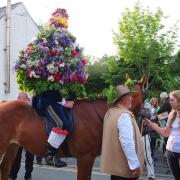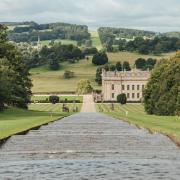The Eastern Moors consist of around 14 square miles of moorland between Sheffield and Chesterfield, all falling within the neighbouring Derbyshire Peak District.
They are managed by the Eastern Moors Partnership, a collaboration between two of the UK’s largest conservation charities, the RSPB and the National Trust.
The Partnership manage the Eastern Moors on behalf of the Peak District National Park as well as the neighbouring Burbage, Houndkirk and Hathersage Moors on behalf of Sheffield City Council.
The moorland hereabout is teeming in the heritage of human activity over thousands of years. A Bronze Age burial cairn on the moor overlooks the Derwent Valley and a nearby system of fields and enclosures have been dated to a similar era.
The moor has also been plundered for its mineral riches, with coal, ganister and fireclay all having been mined here.
One marshy area of the Eastern Moors is called Leash Fen. An old Derbyshire saying runs, ‘When Chesterfield was gorse and broom, Leash Fen was a market town; Now Chesterfield's a market town, Leash Fen is but gorse and broom’.
Whilst it is unlikely to win any poetry prizes, this ditty records the supposed presence here of a formerly prosperous town which one day is said to have sank down into the boggy ground without warning and disappeared, the incident being witnessed by a solitary person stood on nearby higher ground.
When drainage ditches were cut across the moorland in the 1830s, fragments of earthenware pottery were found along with primitive coins and pieces of tool-cut oak which had seemingly been used as poles to support housing, all of which lend a degree of credibility to the yarn.
It isn’t solely humans who have drawn on the moor for its resources. The Eastern Moors are a stronghold for adders as well as being home to birds such as skylark, whinchat, curlew and ring ouzel – all of which are currently on the RSPB’s red list of species of most concern given their levels of recent decline.
But it is the presence here of the UK’s largest native mammal which is responsible for the genesis of this month’s - slightly bizarre - featured tradition.
The red deer which roam the moors (chiefly confining themselves to an area of the Eastern Moors known as Big Moor) are thought to be descendants of escapees from the domestic herd living at Chatsworth, six miles away, who swerved their intended destiny (the freezer at Chatsworth Farm Shop) and settled here around 40 years ago, subsequently breeding.
The moor can support a population of up to 200 deer, and their presence there in such numbers is to the greater good of the moorland ecosystem – alongside cattle, their grazing of the land helps to maintain the habitat to other species’ benefit.
The deer are at their most visible during rutting season which lasts from September to November. During this period the male red deer compete to attract a mate by ‘bolving’ or bellowing loudly.
The annual spectacle of rutting season sees the local deer population increase as animals from surrounding areas are drawn in to congregate on the Eastern Moors.
For the rest of the year the red deer stags have little to do with each other, forming small groups made up of their own gender which only really intermingle again during the next autumn rutting season.
During this time of year when the red deer are at their most visible and vocal, in recent years the Eastern Moors rangers have run a programme of public engagement including guided walks along the moorland to spot the creatures.

But by far the quirkiest event is the annual Bolving Championships, where, for a small fee, members of the public are invited to show up on the moor and perform their best imitation of an amorous red deer stag to see if there is any degree of response from the animals themselves.
The first such championship was staged back in 2014 and is not a uniquely Derbyshire event – a similar competition was held on Exmoor in Devon since 2003 as a consequence of a bet that year between Elvis Afanasenko and Phil Ferris, two drinkers at the Rock House Inn, Dulverton, as to whether they could convincingly imitate a bolving deer to the extent that a real one would answer back.
Phil died the following year and ever since participants have competed for the Phil Ferris trophy in his memory, with money raised going to the Devon Air Ambulance.
As part of my ongoing quest to document Derbyshire’s panoply of folk customs and strange traditions, I paid my fieldwork visit to the Eastern Moors Bolving Championship the second year it ran, back in October 2015.
When I arrived at the designated meeting spot, Barbook Cottage, there were fire pits set up for warmth and displays about the moor’s resident deer as well as a telescope set up on a tripod to try to spot them.
Some of the child attendees were getting into red deer mode by constructing replica antler headdresses out of twigs and branches.
A ranger gave a short talk explaining what bolving was all about and the genesis of the event, describing it as ‘the funniest thing we do all year’, and explaining that it was heavily inspired by the similar one in Devon.

‘There is a World Championship, which is down in the south. And Kim, our senior warden, spotted this and, thought, “Well, we could do that”’.
The ranger explained to the group that the Eastern Moors had attempted to reach out to their Devonian counterparts: ‘We would like to be their county championships, but we haven’t quite got that relationship going with them yet, but we shall see’.
Their plain-speaking Derbyshire (lack of) diplomacy may not exactly have endeared them here; a post on the Eastern Moors blog from October 2014 about the inaugural Eastern Moors competition begins bluntly, ‘There are not too many interesting things that have come out of Devon but one of them is bolving’…
As the evening began to draw in, attendees were invited to walk across the Barbook Dam wall in the gloaming to the edge of the dam, the designated bolving arena.
The rangers judged the event with participants scored on the following qualities: tone, volume and authenticity.

In addition to the prestige and kudos of communing with the deer, there was the added incentive of various prizes on offer – for the adults, medals and certificates as well as first prize of a meal for two at Longshaw; the second prize being a guided walk of the Eastern Moors; and third prize, a bottle of Prosecco.
All child entrants received a certificate, with the winners also being awarded a medal and first prize of a family ticket to an Eastern Moors event and bolving t shirt; with the runners-up receiving a fold-out field guide to deer.
In case you are wondering, I maintained a strictly documentarian stance throughout and didn’t make any attempt to bolve myself, being content to simply photograph and make audio recordings of the other participants’ attempts.
Monday to Friday, these people spend their time doing pedestrian things like working in Derbyshire County Council’s IT department, but out here on the moors in the autumnal dusk of a Saturday evening they unleashed their inner randy red deer and roared with gusto.
Somewhere in the depths of my hard drive I have a three-minute montage of the sound recordings of all the 2015 participants cut together in quick succession - which makes for a deeply odd listen, and would probably require a degree of explanation were it ever to come up in a playlist shuffle.
As far as I can ascertain, the most recent Eastern Moors Bolving Championship was held in 2019, with no 2023 date as yet announced at the time of going to press.
Is this one of Derbyshire’s quirky annual events which has been killed off once and for all by the pandemic, after only a six-year run?

Only time will tell, and the original inspirational World Championships in Devon has also not been held for several years, either.
In the meantime, the deer of Big Moor will probably remain indifferent to such fluctuations, carrying on as they have always done at this time of year and bolving away to attract a mate to ensure that their cycle of life will continue anew – irrespective of whether or not they are joined by human imitators.



























